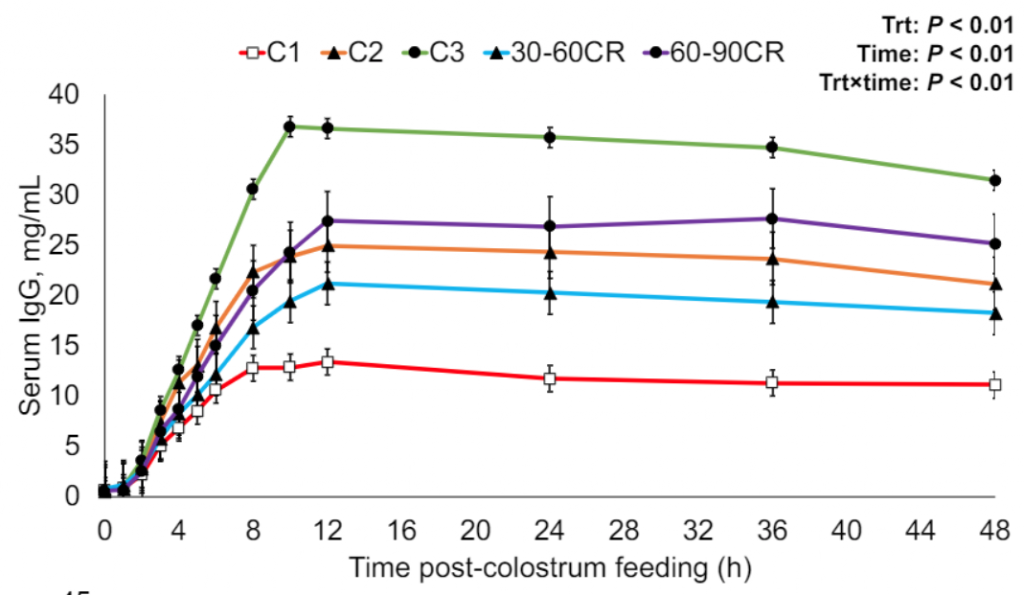Introduction
Colostrum from the cow can vary widely in solids, protein, fat and IgG concentration. We can estimate the overall quality of colostrum by estimating the solids concentration using a BRIX refractometer, but – what happens when we find that the colostrum may be too low in IgG concentration to feed the calf? We generally assume that colostrum with less than about 50 grams of IgG per liter won’t provide enough IgG to provide the calf with satisfactory immunity after 24 hours of life (gut closure).
So, what to do? One approach that has been suggested is to supplement or “boost” maternal colostrum (MC) with a dried colostrum replacer (CR) product. An abstract presented at the 2022 ADSA Annual Meeting from the University of Guelph attempted just that. The results provide an interesting perspective on what happens when we supplement maternal colostrum.
The Research
Male Holstein calves (n = 80;16 calves per treatment) were fed 3.8 liters (1 gallon) of randomly assigned to be fed 3.8 L of MC containing 30 (C1), 60 (C2), or 90 (C3) g of IgG per liter. Treatment C1 was supplemented with 551 g of CR to reach a final concentration of 60 g/L (30–60CR), or C2 was enriched with 620 g of CR to produce a final concentration of 90 g/L (60–90CR). The CR contained 27% IgG, 3.7% fat, 13.6% protein, and 4.3% lactose and was reconstituted to 25.5% solids to be added to MC. All calves were fed with an esophageal feeder. A subset of 40 calves (8 per treatment) had a catheter placed and were fed colostrum with acetaminophen to estimate abomasal emptying rate per h (Ab). Blood samples were collected periodically and analyzed for IgG by radial immunodiffusion and for acetaminophen to estimate abomasal emptying rate.
| Item | C1 | C2 | C3 | 30-60CR | 60-90CR |
| Grams IgG/L | 30 | 60 | 90 | 60 | 90 |
| CR added, grams | 0 | 0 | 0 | 551 | 620 |
| IgG intake, grams | 114 | 228 | 342 | 228 | 342 |
| 24 h serum IgG, g/L | 11.8d | 24.3b | 35.7a | 19.9c | 26.9b |
| 24 h AEA, % | 42ab | 45a | 43a | 36bc | 33c |
| Ab, %/hr | 0.16a | 0.13b | 0.11c | 0.09c | 0.09c |
The Results
Intake of IgG was calculated and is in the Table. Calves fed only MC (C1, C2, and C3) consumed 114, 228, and 342 g of IgG. When treatment C1 was supplemented with CR (30-60CR), the intake was similar to that of C2. Similarly, calves fed C3 and 60-90CR both consumed the same mass of IgG (342 grams).
Serum IgG concentrations increased with advancing age to approximately 12 hours of age, and then were stable thereafter. Calves were fed shortly after birth and were fed only once, so these graphs show the progression of IgG absorption from the first meal.
We can see that feeding increasing concentration of natural colostrum (C1, C2, and C3) resulted in increasing serum IgG concentration, as we would expect. At 24 hours of age, calves fed C1, C2, and C3 had 11.8, 24.3 and 35.7 g of IgG per liter of serum, respectively (Table). The efficiency of absorption didn’t differ with natural colostrum, which was approximately 43%.

According to the treatment design, we should be able to compare C2 and 30-60CR treatments as well as C3 and 60-90CR treatments. In the Table, we see that the 24 hour IgG concentration was lower in 30-60CR compared to C2. However, 30-60CR was higher than C1, which was the MC that was supplemented to make 30-60CR. So, supplementing this poor quality colostrum improved serum IgG, but not quite to the level of natural colostrum.
When we compare C3 and 60-90CR, we see a large difference, with serum IgG in calves fed C3 much higher than the supplemented calves. Also, the difference in serum IgG at 24 hours between C2 and 60-90CR was quite small and not significantly different, suggesting that the addition of CR to MC that was high in quality wasn’t effective in improving serum IgG. These data suggest that you can make poor quality better, but you can’t make good quality colostrum better.
The Interpretation
It’s possible to supplement maternal colostrum with colostrum replacer, but it appears that the best results will occur when poor quality colostrum is supplemented. This research showed that increasing MC from 30 to 60 g of IgG per liter resulted in greater serum IgG concentration. On the other hand, adding CR to high quality MC (i.e., 60 g of IgG/liter) had little effect on serum IgG concentration and reduced efficiency of IgG absorption. A reasonable strategy might be to supplement MC that is <21% BRIX and use MC that is >21% BRIX without supplementation.
References Lopez, A. J., J. Echeverry-Munera, H. McCarthy, A. C. Wellboren, A. Pineda, M. Nagorske, D. L. Renaud, and M. A. Steele. 2022. Effects of enriching maternal colostrum with bovine dried colostrum replacer on IgG absorption in newborn male calves. J. Dairy Sci. Vol. 105, Suppl. 1(Abstr.):323. https://www.adsa.org/Portals/0/SiteContent/Docs/Meetings/2022ADSA/Abstracts_BOOK_2022.pdf?v=20220613